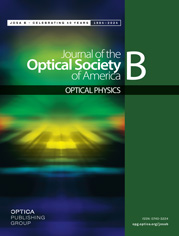Journal of the Optical Society of America B Feature Announcement
Fiber Lasers and Their Applications
Submission Opens:1 September 2016
Submission Deadline: 1 October 2016
Since they were first proposed and demonstrated by Elias Snitzer in 1964, fiber lasers have been the subject of extensive research and development efforts. Due to their attractive characteristics, including compactness, reliable beam quality and low cost of maintenance, fiber lasers have found many applications in telecommunications, environmental monitoring, medical diagnosis and treatment, material processing, and defense.
Impressive progress in the performance of fiber lasers has been achieved through decades of development. Materials researchers have proposed new host material glasses, such as silicate, fluoride, tellurite, and chalcogenide glasses, to extend the operating wavelength from the traditional telecommunications band to the mid-infrared. The development of high power handling fiber devices and rare-earth doped fibers has helped to break the barrier in power scaling. High power operation at 100 kW with a single multimode fiber and 10 kW with diffraction-limited beam quality have been realized.
Current intense research efforts focus on the main limitations, such as mode instability and fiber damage threshold-which restricts further power amplification. The energy and peak power scaling of pulsed fiber lasers is more challenging than with CW fiber lasers due to nonlinear effects. Pulse energy up to 82 mJ generated in large-core multimode nanosecond fiber amplifiers sets the highest energy record. Furthermore, ultrashort fiber laser pulses with duration as short as 4.3 fs have been generated by synthesis of a single cycle of light with compact erbium-doped fiber technology. Additional performance improvements will result from extensive theoretical studies aimed, in particular, at the efficient manipulation of nonlinear effects in optical fibers.
The purpose of this feature issue is to present cutting-edge progress in this exciting field while bringing together new achievements on fiber lasers and their applications. The issue is aimed at scientists, engineers, and practitioners interested in understanding the role of novel physical mechanisms in high performance fiber lasers and exploring their potential applications.
Topics of interest include but are not limited to:
- New glass fiber materials, new fiber design and fabrications
- Single frequency fiber lasers (CW and pulsed)
- High power fiber lasers and amplifiers (including fiber oscillators, fiber lasers in MOPA configuration, and fiber combination of fiber lasers)
- High average power, high peak power, or high energy pulsed fiber lasers
- Fiber coupled pump sources
- Mode-locked fiber lasers, and fiber amplifications of picoseconds and femtosecond fiber laser pulses
- Supercontimuum fiber laser sources and fiber-based OPO
- Research of fiber laser applications
All papers need to present original, previously unpublished work, and will be subject to the normal standards and peer-review process of the journal. Manuscripts must be prepared according to the usual standards for submission to JOSA Band must be uploaded through OSA's electronic submission system. When submitting, please specify that the manuscript is for the Fiber Lasers and Their Applications feature issue (choose from the drop-down menu).
Feature Issue Editors
Shaif-ul Alam, Optoelectronics Research Centre, University of Southampton, UK
Rodrigo Amezcua, CREOL, University of Central Florida, USA
Axel Schulzgen, CREOL, University of Central Florida, USA
Wei Shi, Tianjin University, Tianjin, China
Xiushan Zhu, OSC of University of Arizona, Arizona, USA

